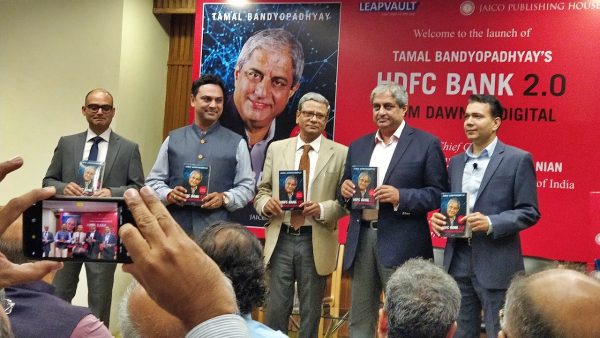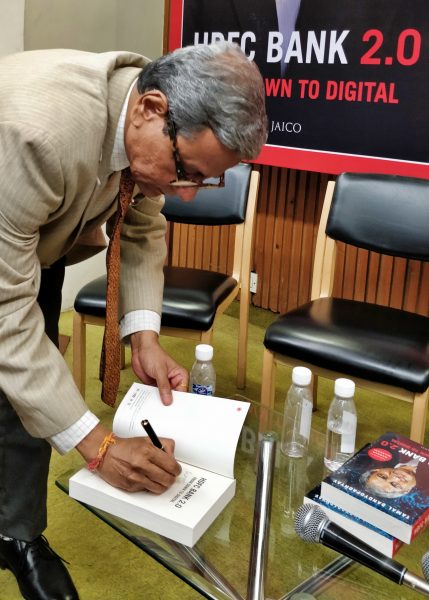Who says bankers are boring?
This book has the heart of a novel and the mind of an information treasure trove…

Tamal Bandhyopadhyay ‘tells the exciting tale of how HDFC Bank has transformed itself, especially in the past few years with its digital journey,’ writes Nandan Nilekani in his forward to `HDFC Bank 2.0: From Dawn to Digital’.
The book goes to the inception stage of the bank and is brimming with anecdotes that are literally bubbling with a fervor that is both serious in intent and extremely readable. The way we look at HDFC Bank today is that it effectively ‘combines global trends in technology like smartphones, AI, the cloud, etc. with the state-of-the-art infrastructure that India had built as digital public goods – Aadhaar, eKYC, Unified Payments Interface (UPI) and other elements of the India stacks. We know that its chatbot, the Electronic Virtual Assistant (EVA), now handles 6,00,000 queries a month and has completed 8.7 million interactions since its launch’ as Nilekani goes on to say in his foreword.
Tamal’s first book ‘A bang for the buck’ was written in 2012 and, its sequel, HDFC 2.0 was launched in July 2019, coinciding with the bank’s 25th anniversary.The book reads like a thriller and a romance and yet maintains the seriously fact-filled stance of a work that has informative value for future generations who have an interest in fiscal intricacies.
I must mention here Dr Krishnamurthy Subramanian (Chief Economic Advisor, Government of India), Aditya Puri (MD, HDFC Bank), Rajnish Kumar (Chairman, State Bank of India) and Nilekani, among others from the banking, financial and technology worlds, who were present at different launches of the book across three Indian cities had free-wheeling conversation with the audience, laced with humour, serious comments on strategy and trends on banking.
Dr Subramanian pointed out that ‘the lessons that are there in the book have relevance for the country as well as the banking sector, especially, you know, the importance of technology today. And that’s something that many of our banks can certainly learn.’
The transition from conventional or analog banking to one that was thoroughly soaked in the vibrant hues of new-age technological innovations obviously happened because of a leader who was willing to listen to the whispers of the future. After all, these whispers were all about somebody using a simpler process to give a loan faster, at a lower cost, a better process that walked the talk with telecommunications, computing, social mobility and artificial intelligence.
The book is extremely readable and much more than that. It diligently jots down every little story that sum up what HDFC Bank represents. The stories span both the analog and the shift to technology years. The story of the lucky 13 being chosen in the initial stages is fascinating. They were free to ‘bring their own people to the bank, people who would share the same dream and passion’ but these teams were not to be too large as ‘this would make it difficult for HDFC Bank to evolve its own culture’.
The short but incisive snippets about Monday morning meetings to transform an abstract vision into actions that discernably moved ahead, all those training sessions under a tree to bring home the fact that visions of success do not get obfuscated by mundane obstacles, and the ways in which problems like ATM malfunctioning were solved are enchanting, to say the least. The readers will love the way tequila shots in the evenings hobnob with chromosomal ideas, revolving around spending less but spending smart to get a fair insight into the path that the bank had adopted.
The financial wizards who had taken charge of raising this baby realized soon enough that they ‘couldn’t be a big bank dealing with only triple-A clients’ and thus began their march into the arena of retail banking as this was the right way to create maximum value. The “story” of HDFC Bank begins and sticks to the primal concept of making banking simple and one of the mantras that gets mentioned often is the ability of their think-tank to sniff every opportunity.
I wasn’t really surprised to find the author admitting that ‘HDFC Bank is staid and waits for opportunities but emerges a winner at the end of the day’. Success sans flamboyance forms the genetic code of the bank and even Nilekani’s foreword mentions that the bank is ‘monotonously predictable on most financial parameters’. After all, Prui’s vision ‘was to create an Indian bank that could compete with the best on global parameters. India’s economic liberalization, he believed, would give the new bank a fantastic opportunity.’
The benefit of yearning to be able to compete with the best also means not becoming a dinosaur in the tech-savvy world of new-age banking. As Puri said in the discussion during the launch of this book, ‘There’s no problem that cannot be solved with the help of technology. Technology can solve a problem. But you have to define what solution you want. So it’s not going to be the be all and end all.’
What matters most is staying ahead of the curve and ‘change what is necessary for the future’. For instance, HDFC Bank had ‘foreseen the digital banking revolution and knew a convergence would happen and people would want everything on phone’. The way things are moving today, ‘uninterrupted existence, proven track record, investment in advanced technology to understand customer behaviour, the ability to invest in innovations and right platforms, and the willingness to partner with big players’ are going to give consumers the right reasons to go on placing their trust in banking. Quite obviously then, the ‘next phase of growth will be driven by digital strategy’.
What comes through effectively in the book is the way change management was harnessed because the tenets of behavioural economics does mention that people have a lot of inertia and are resistant to change. It is thus the choice architecture that needs to be kept going at the right pace and in the right direction. The bank realized that digitization has a creatively catalytic impact on almost every aspect of banking, that data and technology can give enough information to make sane decisions, and yes, technology ensures that a larger geography can be reached.
This book has the heart of a novel and the mind of an information treasure trove. It is obviously a work of non-fiction that isn’t going to be dated ever as the author has chronicled facts connected to actions that have led to where HDFC Bank stands today.
In more than one ways, this book isn’t just about a bank but about banking and the way banking needs to anticipate the future and take critical decisions. And yes, banking is full of remarkable stories that can all come together to stitch a chapter in business strategy. This book tells me that banking isn’t boring at all.
.
Book details:
Title: HDFC Bank 2.0 – From dawn to digital
Author: Tamal Bandyopadhyay
Publisher: Jaico Publishing House
ISBN: 978-93-88423-35-9
.
.


.
.
.
Arvind Passey
14 August 2019








